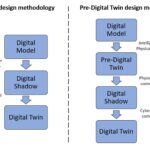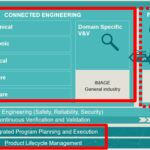Digital twins are getting lots of deserved attention, but are they the cure-all for whatever simulation issues you have?
Lately, I’m seeing what are called “digital twins” cited everywhere. What is a digital twin?
In addition to having that very catchy name, it is a highly advanced model of the system which can be used to analyze current behavior and even ongoing performance—in theory. One proponent (Reference 1) defines it as “… a dynamic virtual copy of a physical asset, process, system, or environment that looks like and behaves identically to its real-world counterpart.”
A digital twin ingests data and replicates processes so you can predict possible performance outcomes and issues that the real-world product might undergo.” IBM (Reference 2) says “A digital twin is a virtual representation of an object or system that spans its lifecycle, is updated from real-time data, and uses simulation, machine learning, and reasoning to help decision-making.”
OK, I get it…it’s a super model and simulation. In fact, the IBM link briefly explains why a digital twin is more and better than a mere simulation. And what about hardware-in-the-loop (HITL)—the hot buzzword of a few years back? It’s still in the toolkit, of course.
One general description says that for a digital twin, you create a software-only model of the system being controlled, and then provide it with inputs and outputs from your controller being tested, to see how well your controller acts as it does what it is supposed to be doing (Figure 1).

In contrast, for HITL you build a software model of the core, but have it interface with and direct real hardware (circuitry and mechanical) to assess the performance of your controller (Figure 2). In other words, and grossly oversimplifying, digital twins are pretty much all software-based models and transducer replicas while HITL has, as the name implies, more real-world circuitry and even electromechanical components.

An example using an automobile engine and its ECU (electronic control unit) may make this clearer. For the DT scenario, you model the engine entirely as a software construct, and this model “talks” to the software of the controller being developed. In contrast, for HITL, you model the engine, but now the model software drives real circuitry I/O to the controller under development, which then sees those interfaces.
In contrast, the HITL often requires a rack of equipment, meaning substantial amounts of circuitry (Figure 3). One of the appeals of DTs is that they eliminate the need for most if not all of this pesky “hardware,” of course.

How does all this link to the Gartner hype cycle? “Hype cycle”—what’s that? In brief, their hype cycle is an analysis and graphic representation developed by that market research/consulting firm of what’s hot and not, and what’s where in a five-stage cycle from idea to market success (Figure 4) (Reference 3 is a good explanation).

There are actually several different versions covering different topics, such as artificial intelligence, digital marketing, and emerging technologies (Figure 5). Each version is updated annually, so you can see Gartner’s perspective on where things are and how they are moving along the cycle year to year.

The next part further explores the utility and limitations of digital twins.
Related EE World Content
- Cloud-based digital twin helps improve EV battery performance
- What’s a digital shadow and how does it relate to a digital twin?
- How do digital threads & digital twins fit in MBSE?
- Digital-twin simulation includes auto hardware/software sub-systems, full vehicle models, sensor data, traffic flows and more
- Hardware in the Loop Simulation for EV/HEV Drivetrain Development
- Basics of time-synchronized hardware-in-the loop testing
- Hardware-in-the-loop systems speed electric vehicle development tasks
- Hardware-in-the-Loop Testing Meets Wireless System Challenges
- COTS hardware-in-the-loop simulators target auto and aerospace apps
External References
- Unity Technologies, “What is a digital twin?”
- IBM, “What is a digital twin?”
- BMC Software, “Introduction to the Gartner Hype Cycle”
- Nature, “Fast charging of energy-dense lithium-ion batteries“ (abstract only) and First published page and Figures
- IEEE, “Extending Life of Lithium-Ion Battery Systems by Embracing Heterogeneities via an Optimal Control-Based Active Balancing Strategy” (abstract only) and Full Paper
- Opal-RT, “The ‘Digital Twin’ in Hardware in the Loop (HiL) Simulation: A Conceptual Primer”
- Athens Group, “Digital Twin Gets Its Due”
- Smart Robotics, “Using digital twin and hardware-in-the-loop simulations to speed up robot development & integration”
- NI, “Hardware-in-the-Loop (HIL) Test”
- NI, “What Is Hardware-in-the-Loop?”
- Add2, “Hardware-in-the-loop testing applications”
- The MathWorks, “What Is Hardware-In-The-Loop Simulation?”
- Deloitte, “Industry 4.0 and the digital twin”
- Slideshare, “Digital Twins”
- OSIsoft, “Digital Twins: Myths vs. Reality”
- WiPro, “Digital Twin: Innovate the Way to Test”
- EE Times,“Don’t ‘Twin’ Digital Twins and Simulations”





